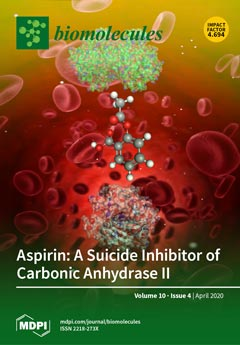Bovine submaxillary mucin (BSM) is a gel-forming glycoprotein polymer, and Ser/Thr-linked glycans (
O-glycans) are important in regulating BSM’s viscoelasticity and polymerization. However, details of
O-glycosylation have not been reported. This study investigates the structural and quantitative characteristics of
O-glycans
[...] Read more.
Bovine submaxillary mucin (BSM) is a gel-forming glycoprotein polymer, and Ser/Thr-linked glycans (
O-glycans) are important in regulating BSM’s viscoelasticity and polymerization. However, details of
O-glycosylation have not been reported. This study investigates the structural and quantitative characteristics of
O-glycans and identifies
O-glycosylation sites in BSM using liquid chromatography–tandem mass spectrometry. The
O-glycans (consisting of di- to octa-saccharides) and their quantities (%) relative to total
O-glycans (100%; 1.1 pmol per 1 μg of BSM) were identified with 14 major (>1.0%), 12 minor (0.1%–1.0%), and eight trace (<0.1%)
O-glycans, which were characterized based on their constituents (sialylation (14
O-glycans; 81.9%, sum of relative quantities of each glycan), non-sialylation (20; 18.1%), fucosylation (20; 17.5%), and terminal-galactosylation (6; 3.6%)) and six core structure types [Gal-GalNAc, Gal-(GlcNAc)GalNAc, GlcNAc-GalNAc, GlcNAc-(GlcNAc)GalNAc, and GalNAc-GalNAc].
O-glycosylation sites were identified using
O-glycopeptides (bold underlined;
56SGE
TR
TSVI,
259SH
SSSGR
SR
TI,
272G
SP
SSV
SSAEQI,
307RP
SYGAL,
625Q
TLGPL,
728TM
TTR
TSVVV, and
1080RPEDN
TAVA) obtained from proteolytic BSM; these sites are in the four domains of BSM. The gel-forming mucins share common domain structures and glycosylation patterns; these results could provide useful information on mucin-type
O-glycans. This is the first study to characterize
O-glycans and identify
O-glycosylation sites in BSM.
Full article






